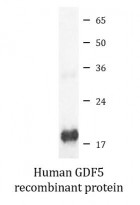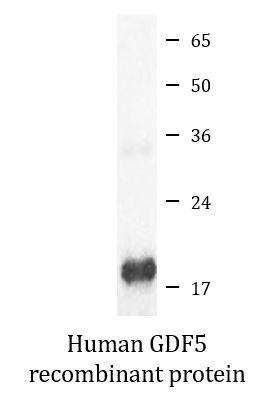Human GDF5 recombinant protein (Active) (His-tagged, C-ter)
CAT.NO. : ARG70100
US$ Please choose
US$ Please choose
*产品价格可能会有所调整,请以品牌方官网实时更新的价格为准,以确保准确性。
概述
| 产品描述 | E. coli expressed, His-tagged (C-ter) Active Human GDF5 recombinant protein |
|---|---|
| 应用 | SDS-PAGE |
| 靶点名称 | GDF5 |
| 物种 | Human |
| A.A. 序列 | Ala382 - Arg501 |
| 表达系统 | E. coli |
| 生物活性 | Active |
| 活性说明 | Determined by its ability to induce alkaline phosphatase production by ATDC5 cells. The ED50 for this effect is |
| 別名 | Cdmp-1; GDF-5; Growth/differentiation factor 5; Bone morphogenetic protein 14; brp; BMP-14; bp |
属性
| 形式 | Powder |
|---|---|
| 纯化说明 | Endotoxin level is less than 0.1 EU/µg of the protein, as determined by the LAL test. |
| 纯度 | >98% (by SDS-PAGE) |
| 缓冲液 | 20 mM sodium citrate and 0.2 M NaCl (pH 3.5) |
| 复溶 | It is recommended to reconstitute the lyophilized protein in 4 mM HCl to a concentration not less than 200 μg/mL and incubate the stock solution for at least 20 min at room temperature to make sure the protein is dissolved completely. |
| 存放说明 | For long term, lyophilized protein should be stored at -20°C or -80°C. After reconstitution, aliquot and store at -20°C or -80°C for up to one month. Storage in frost free freezers is not recommended. Avoid repeated freeze/thaw cycles. Suggest spin the vial prior to opening. |
| 注意事项 | For laboratory research only, not for drug, diagnostic or other use. |
生物信息
| 基因名称 | Gdf5 |
|---|---|
| 全名 | growth differentiation factor 5 |
| 生物功能 | Growth factor involved in bone and cartilage formation. During cartilage development regulates differentiation of chondrogenic tissue through two pathways. Firstly, positively regulates differentiation of chondrogenic tissue through its binding of high affinity with BMPR1B and of less affinity with BMPR1A, leading to induction of SMAD1-SMAD5-SMAD8 complex phosphorylation and then SMAD protein signaling transduction (By similarity). Secondly, negatively regulates chondrogenic differentiation through its interaction with NOG (By similarity). Required to prevent excessive muscle loss upon denervation. This function requires SMAD4 and is mediated by phosphorylated SMAD1/5/8. Binds bacterial lipopolysaccharide (LPS) and mediates LPS-induced inflammatory response, including TNF secretion by monocytes (By similarity). [UniProt] |
 New Products
New Products





















